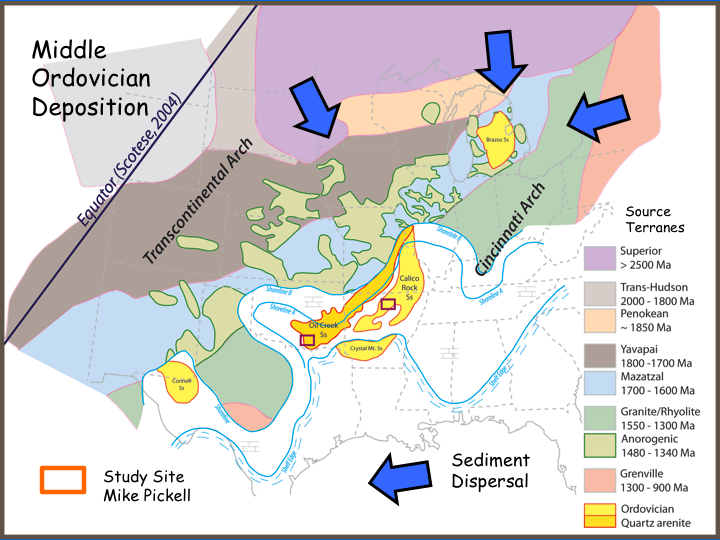58th Annual Report on Research 2013 Under Sponsorship of the ACS Petroleum Research Fund
Reports: ND851156-ND8: Sequence Stratigraphy, Detrital Zircon Geochronology, and Shale Geochemistry of Middle to Late Ordovician Quartzites in North America to Understand Provenance, Sediment Dispersal and Paleoclimate
Michael C. Pope, Ph.D., Texas A&M University
Mario Lira submitted an abstract to be presented at the National AAPG Meeting in Houston, April 6-9, 2014 on his M.S. results.
The main results of the research so far are:
1) Detrital zircons for Middle-Late Ordovician quartz arenites of the western U.S. are remarkably similar indicating a uniform provenance from the Transcontinental Arch, mostly from the Trans-Hudson Orogen (1.8-1.9 Ga) and Archean terranes (2.5-2.9 Ga) such as the Wyoming Province. Almost all samples also include populations of 2.1 Ga zircons, and 0.8 – 1.2 Ga grains. The source for the 2.1 Ga grains is currently unknown, and the young zircons are derived from recycling Neoproterozoic-Cambrian quartz arenites.
2) Detrital zircons for the Middle-Late Ordovician quartz arenites of the U.S. Midcontinent are quite dissimilar from the samples on the other side of the Transcontinental Arch containing major populations of 0.9-1.2 Ga, 1.4-1.5 Ga, 1.6-1.7 Ga, 1.8-1.9 Ga, and 2.4-2.8 Ga detrital zircon grains. The amount of Grenville age zircons, and zircons from 1.6-1.7 Ga (Yavapai-Matzatzal) source terranesare much larger than in the western US samples.
3) Changes in detrital zircon populations between the base and top of a unit (see TOC) indicates long-term sea level fluctuations controlled the source(s) of sediment for these units by burying or exposing the basement rocks along the Transcontinental Arch available for erosion and subsequent deposition.
4) There appears to be little recycling of pre-existing siliciclastic units during deposition of the Middle-Late Ordovician quartz arenites.
Both Mario and Diar have completed much of the research for their graduate degrees, and during the past year we had hoped to finish most, if not all, of our detrital zircon analyses from the western U.S. and the U.S. Midcontinent. However, the LA-ICP-MS at Texas A&M has had a series of technical difficulties that until recently were difficult to diagnose and fix (see attached letter). However, it looks as if the repairs are now completed and we should have both Diar's and Mario's data completed by January, 2014. If there are further delays with using the Texas A&M facility we plan to make arrangements to use the LA-ICP-MS at Washington State University. Additionally, we are planning to analyze the few shale samples that occur within the quartz arenites to use their CIA index to determine paleoclimateduring deposition.
This grant has allowed me to follow an entirely new line of research, detrital zircon geochronology, and it has lead to numerous collaborations at Texas A&M between Dr. Brent Miller, Dr. Tom Yancey, and me. This grant has provided Research Assistantships for Mike Pickell and Mario Lira and will provide the bulk of the funding for the analyses for Mike Pickell, Mario Lira, and DiarIbrahim's detrital zircon samples, teaching them quantitative techniques and how to integrate these into fundamental stratigraphic correlation to solve problems. This skill will likely provide all three of them with a good background for successful careers in the petroleum industry.
Copyright © 2014 American Chemical Society
















